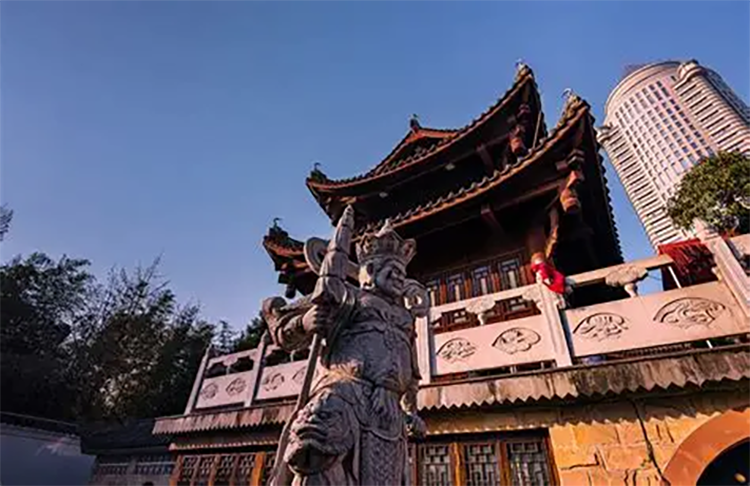Guiyang Temple Guide: Discover Qianming Temple’s Zen Heart
Hidden in Guiyang’s bustling Nanming District, Qianming Temple (黔明寺) is a quiet Zen sanctuary that seems to watch the city’s changes from a mountain slope. Built into the hillside, the temple greets visitors with a stone path flanked by ancient trees, incense smoke, and the low cadence of chanting—an immediate passage from urban noise into a calm, solemn world. As one of Guiyang’s oldest Buddhist temples, Qianming is not only a sacred site for devotees but also a living chronicle of central Guizhou culture, waiting to be discovered.
1. History: A Buddhist Treasure of War and Rebirth
Qianming Temple traces its origins to the late Ming and early Qing eras—almost 400 years ago. It has witnessed Guiyang’s transformation from a frontier town into a modern city and survived cycles of destruction and renewal. During the Xianfeng years of the Qing dynasty, the Taiping Rebellion reached Guizhou and left the temple nearly ruined, yet local believers and monks repeatedly restored it so that its incense never went out. In 1983 Qianming Temple was listed as a protected cultural relic by Guizhou Province, affirming its historical value.
As an important Chan (Zen) center of Chinese Buddhism, Qianming Temple holds a unique place in Guizhou’s religious history. It is one of the few surviving Ming–Qing architectural ensembles within Guiyang and combines central plains Chan traditions with local mountainous building practices, making it a “living fossil” for studying the spread of Buddhism in southwest China.
2. Architecture and Art: Han Zen Style Meets Mountain Wisdom
Qianming Temple follows the traditional Han Chinese Buddhist layout of the “seven halls” (gālān qītáng), arranged along a central axis: the mountain gate, Hall of the Heavenly Kings, Mahavira Hall, and the Guanyin Hall. The overall aesthetic is rooted in Ming–Qing official temple design, while cleverly adapting to Guizhou’s terrain—stepped platforms that follow the slope save space and create a layered sense of procession.
The Mahavira Hall is the temple’s heart. Its single-eave, xieshan roof and upturned eaves resemble wings in flight. Although the painted bracketwork has weathered over time, fine decorative patterns remain visible. Inside, a gilded Shakyamuni statue sits as the main deity, flanked by eighteen arhats in varied poses; their flowing robes showcase the skill of Qing-era Guizhou folk sculptors. Especially precious is a Ming-dynasty woodblock edition of the Diamond Sutra preserved inside the hall—its clear characters are a valuable resource for studying Buddhist scripture transmission.
The Guanyin Hall radiates warmth and accessibility. The gold-leafed Thousand-armed Guanyin looks down with compassion, set against a carved backdrop depicting central Guizhou’s mountains and waters. This fusion of Buddhist iconography with local karst landscape imagery is uniquely regional.
3. An Immersive Experience: Zen Life at Dawn and Dusk
Every morning at 5:00, the monks’ chanting rings through the halls. Visitors can stand quietly outside and experience the otherworldly sound of sutras weaving through the trees. On Buddha’s birthday or lunar first and fifteenth days, the temple holds blessing ceremonies where worshippers walk around the Buddha carrying lotus lanterns—a solemn, moving sight.
Visitor tips:
– You may take three complimentary incense sticks from the mountain gate and offer them in the order center, right, left.
– A donation box sits beside the Guanyin Hall; please keep voices low when giving.
– For a deeper experience, weekend Zen meditation classes are sometimes offered—call ahead to reserve.
4. Setting and Atmosphere: A Mountain Hermitage in the City
Unlike many tourist-heavy temple sites, Qianming Temple retains an authentic monastic atmosphere. About 70% of visitors are local middle-aged and elderly devotees walking with prayer beads and slow steps; they often smile warmly at visitors. Afternoon sunlight filters through ancient ginkgo leaves across the courtyard—an ideal time to sit on a stone bench, listen to wind chimes, or watch monks copying sutras in the tea room.
A little-used trail behind the temple leads to a vantage point overlooking Guiyang’s old town. One highlight is an osmanthus tree said to have been planted during the Ming dynasty; in autumn its delicate fragrance is unforgettable.

5. Practical Guide: Planning Your Visit to Qianming Temple
Opening hours: 7:00–17:30 (free admission)
Best time to visit: Arrive between 7:00 and 9:00 to observe the morning chanting and avoid afternoon tour groups.
Getting there:
– Metro: Line 1, Hebin Park Station (Exit B); about an 800-meter walk.
– Bus: Take routes 15 or 34 to Yangming Road stop, then cross the Nanming riverside cultural promenade to the mountain gate.
– Car: No dedicated parking at the temple; nearby Cultural Road underground parking is available (RMB 5/hour).
Etiquette:
– Avoid stepping on thresholds; circumambulate clockwise.
– Turn off camera flash when photographing statues; silence phones during ceremonies.
– Dress modestly—cover shoulders and knees; bring a light jacket in summer for temple interiors.
Nearby attractions:
– A ten-minute walk brings you to Jiaxiu Tower, a classic southern city landmark.
– Pair your visit with the Guizhou Provincial Museum (about 3 km) to learn more about the region’s ethnic cultures and Buddhist interactions.

Conclusion: Encountering Timelessness in Time’s Folds
Qianming Temple’s charm lies in how its deep history becomes a tangible present. Free from commercial clutter, it offers the Zen hidden in tree rings and the sunlight that dances on tiled eaves. Whether you seek a place for quiet reflection or an entry point into central Guizhou culture, this hillside monastery tucked inside the city will exceed expectations. Before you leave, scoop a cup of water from the old well at the mountain gate—locals call it the “Well of Wisdom,” believing its clear spring can wash away fatigue and distill travel insights into lasting life wisdom.


